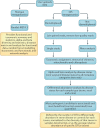Standardization of microbiome studies for urolithiasis: an international consensus agreement
- PMID: 33782583
- PMCID: PMC8105166
- DOI: 10.1038/s41585-021-00450-8
Standardization of microbiome studies for urolithiasis: an international consensus agreement
Abstract
Numerous metagenome-wide association studies (MWAS) for urolithiasis have been published, leading to the discovery of potential interactions between the microbiome and urolithiasis. However, questions remain about the reproducibility, applicability and physiological relevance of these data owing to discrepancies in experimental technique and a lack of standardization in the field. One barrier to interpreting MWAS is that experimental biases can be introduced at every step of the experimental pipeline, including sample collection, preservation, storage, processing, sequencing, data analysis and validation. Thus, the introduction of standardized protocols that maintain the flexibility to achieve study-specific objectives is urgently required. To address this need, the first international consortium for microbiome in urinary stone disease - MICROCOSM - was created and consensus panel members were asked to participate in a consensus meeting to develop standardized protocols for microbiome studies if they had published an MWAS on urolithiasis. Study-specific protocols were revised until a consensus was reached. This consensus group generated standardized protocols, which are publicly available via a secure online server, for each step in the typical clinical microbiome-urolithiasis study pipeline. This standardization creates the benchmark for future studies to facilitate consistent interpretation of results and, collectively, to lead to effective interventions to prevent the onset of urolithiasis, and will also be useful for investigators interested in microbiome research in other urological diseases.
Conflict of interest statement
The authors declare no competing interests.
Figures
References
Publication types
MeSH terms
LinkOut - more resources
Full Text Sources
Other Literature Sources


